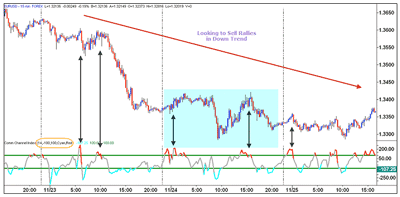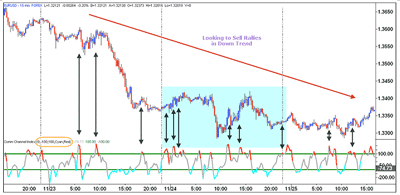From a technical analysis perspective, I prefer to base my trading decisions primarily on the ongoing dynamics of supply and demand principles, says Sam Evans of Online Trading Academy, because this is pretty much the most objective analytical approach available, mainly due the simple fact that the very best indicator of where price is likely to go next is price itself.
However, while this approach formulates the core methodology of my trading plan and activities, I also deeply respect a handful of the other technical tools and analysis methods that are widely available to traders of all skill levels. Sure, I would never just take a trade based purely on a buy or sell signal generated by a technical indicator alone, but with this being said, these tools can provide a powerful role in aiding the overall market assessment process. As traders, we simply need to understand that there is absolutely no such thing as a leading indicator. There is no perfect trigger available, and until machines can consistently predict the future, then things are unlikely to change anytime soon.
Two Categories of Indicators
I have found in my experiences as a trader that while there is undoubtedly a huge selection of technical indicators built into most quality trading and charting platforms, after time experimenting with them all it becomes clear that where most are concerned, they can be divided into two separate categories: Momentum based and oscillator based, with the former more widely used for the most basic buy and sell signals. Occasionally, when a dominant trend is in play in the marketplace, just relying on support and resistance levels alone means that much of the trend is lost to the trader, thus forcing them to sit on their hands and wait for a better time to enter the market. However, by using an oscillator from time to time during these scenarios, the objective and patient trader can often be given a chance to step into the action, ideally when looking to short rallies in downtrends or buy pullbacks in uptrends.
The most common of the oscillator family of indicators would include the likes of the RSI (relative strength indicators), the CCI (commodity channel index), and Stochastics. I have worked with and continue to teach my students in the Online Trading Academy classroom and ongoing Extended Learning Track (XLT) graduate program the benefits of these tools when used in the right circumstances (and only the right circumstances I might add!).
The oscillator anyone chooses to use is really entirely up to personal taste, but I would never recommend using more than one at a time purely for the reason that in essence, all three do exactly the same job. While the RSI is formulated based on relative strength of price, Stochastics are instead based on systematic higher and lower price closings. The CCI computes its results from the change in price in comparison to previous price fluctuations. So, while each individual indicator has a slight difference in its calculation method, they all have the common thread of showing a trader signs of when a market is potentially "overbought" or "oversold," leading to some key potential opportunities to join the current trend.
Each indicator is formulated from the price data itself, so we must always remember that often the indicator can give us a very late entry signal, therefore increasing the risk and draining the reward potential simultaneously. There is, though, a solution to this problem with all oscillators and that resides with the actual amount of price data the indicator is programmed to work with. You see, no matter the technical tool to be used and its own bespoke method of calculation, they all need a certain amount of price data to function. This setting can often be found labeled the period of length setting, depending on the charting software being used. Typically, the default setting is the original amount of data used for the calculation, as was first intended by the indicator's creator or designer.
As a rule of thumb, I encourage students of the market to use the default setting when working with an indicator of any kind, as this was the original setting employed by the tool's creator and is a good average to work with. We can, however, change the period setting at will, either speeding up the amount of entry signals given by the indicator, or instead adding more periods to provide fewer buy and sell triggers.
NEXT: See Both Indicator Settings in Action
|pagebreak|Changing this setting comes with its own pros and cons as we can see in the example below:
Here we have a 15-minute intraday chart of EUR/USD in a downtrend, with a simple CCI indicator applied and using the default setting of 14 periods. As we can see, during the price fall, there were a number of rallies produced that gave us overbought sell triggers on the CCI. Using the simple rule-based method, the trader had some solid opportunities to get involved, with the only mixed signals appearing during the highlighted range-bound price action. Now let's go to a chart with the CCI applied using the faster setting of a custom nine-period:
In this example, we can see that while the CCI did give us winning entries, it also gave many more false signals as well, especially during the same highlighted range-bound area, inviting the trader to enter the market short prematurely and resulting in being chopped to pieces before the price went lower. The advantage of speeding the indicator periods up does provide a trader with the chance to get closer to the action on occasion, but the fact that the CCI is using less data, it is therefore giving more signals with less probability. On the other hand, the 14-period setting misses out on some earlier entries, but with fewer triggers, it also saves the disciplined trader a run of losses during the ranging period.
Think of the difference between the 9-period setting and the 14-period setting like comparing the time it takes for a sports car and an articulated truck to perform a U-turn-one can do it in the flash of an eye, making it hard to see what's coming, while the other goes at a slower pace, allowing you to follow the action with plenty of time to observe.
By Sam Evans, instructor, Online Trading Academy











